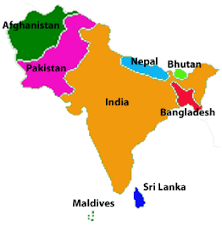02 Aug 2022 South Asia is in a flux. India must show leadership

- South Asia is the southern region of Asia, defined in both geographical and ethno-cultural terms. The region includes Afghanistan, Bangladesh, Bhutan, India, Maldives, Nepal, Pakistan and Sri Lanka.
- India’s vision of regional economic integration in South Asia is based on greater intra-regional trade, investment flows and regional transport and communication links in South Asia. The South Asian Association for Regional Cooperation (SAARC) and India’s ‘Neighborhood First’ policy are two ways of pursuing this approach.
- Although there are shared cultural roots among the countries of this region, there are many sub-regional challenges such as political and economic instability (Sri Lanka crisis and Afghanistan crisis), high inflation, dwindling foreign exchange reserves and domestic unrest that affect the total population of the world. Problems remain for this land, which carries about a quarter of the land.
India’s ‘Neighbourhood First’ Policy
- India’s ‘Neighbourhood First’ policy embodies India’s vision of building ‘Vasudhaiva Kutumbakam’.
Development aid:
- India has allocated Rs 62,920 million in its budget for the year 2022-23 for development assistance to neighboring countries and countries of Africa and Latin America.
‘Vaccine Diplomacy’:
- India, through its ‘Vaccine Diplomacy’ or ‘Vaccine Maitri’ as a part of its Neighborhood First policy, has assisted many countries of the world (especially neighboring countries) during the COVID-19 pandemic.
Challenges in the Path of Regional Cooperation in South Asia
Low level of intra-regional trade:
- South Asia’s intra-regional trade is among the lowest globally, accounting for only 5% of the region’s total trade. The current economic integration is only a third of its potential, with an annual gap estimated at $23 billion.
External influences in South Asia:
- India’s smaller neighbors have been trying to balance India’s influence through close ties with external powers. In this sequence, in the past they have been under the influence of America and in the present they are under the influence of China.
- Recent Chinese actions and policies in South Asia and its maritime neighborhood (including island nations in the Indian Ocean region) have made it necessary for India to take its relations and engagement with its neighbors very seriously.
Regional Issues:
- Territorial disputes in South Asia remain a challenge to the peace, stability and prosperity of the region.
-
Of all the inter-state disputes, ongoing disputes over territory and borders are more likely to lead to armed conflict.
Inefficient management of the global supply chain:
- South Asia’s international trade integration is lower than the global average and is less integrated into global value chains than East Asia.
- Due to the low productivity of many countries in this region, the exports of these countries are extremely low.
What role can India play in the development of South Asia?
Promotion of regional trade:
- India can strengthen the ‘South Asian Free Trade Agreement’ as a ‘game-changer’ for the region, taking advantage of regional trade, connectivity and investment.
- Promoting economic energy will reduce barriers to intra-regional food trade and encourage regional supply chains.
Providing ‘Eco-Blueprint’:
- South Asian countries can benefit from India’s eco-blueprint with a focus on conservation of biodiversity and response to the climate crisis. The link between effective governance and sustainable development in South Asian countries also needs to be acknowledged.
Underlining the need for food security:
- Regional food security is another area in which India can take a major initiative keeping in mind the future and can be an integral facilitator and component of this economic bloc for food security.
- From this point of view it is also necessary to increase the capacity of SAARC Food Bank which is currently less than 500,000 MT.
Taking forward sub-regional initiatives:
- India can enhance the organizing capacity of sub-regional initiatives such as Bay of Bengal Initiative for Multi-Sectoral Technical and Economic Cooperation (BIMSTEC).
- Border regions can be effective partners in shaping India’s regional engagement by conducting subject-wise regional dialogues on cross-border trade, transport and health.
- India can strengthen its position in the region by extending necessary assistance and gain both economic and strategic depth compared to China.
Voice of South Asia in International Forums:
- India as a group can become the voice of South Asia in international forums to promote the interests of South Asian countries. A secure regional environment will also help India reach its ambitious development goals.


No Comments